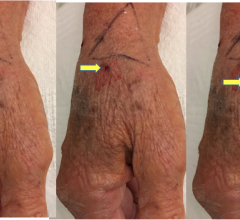Effect of Duration of Hemostatic Compression on Radial Artery Occlusion After Transradial Access
Samir B. Pancholy, et al; Catheter Cardiovascular Interventions. May 16, 2011. doi: 10.1002/ccd.22963.
Study design:
• 400 patients undergoing TR-PCI randomized to either two or six hours of hemostatic compression using the TR band
• Patent hemostasis technique was utilized for both groups
Primary endpoint:
• Early (24 hours) and chronic (30 days) radial artery occlusion
Results:
• Less early and late radial artery occlusion in the two-hour group
• Occlusive compression was the only predictor of radial artery occlusion
Bottom line:
• Prolonged hemostatic compression is associated with a higher rate of radial artery occlusion
Operator Radiation Exposure During Percutaneous Coronary Procedures Through the Left or Right Radial Approach: The TALENT Dosimetric Substudy
Alessandro Sciahbasi, et al; Circulation Cardiovascular Interventions. 2011;4:00-00.
Study design:
• 390 patients randomized to right versus left radial access. Operators remained on the patient’s right side for all procedures
• Three operators were outfitted with five dosimeters (left wrist, shoulder, thorax outside the lead apron, thorax under the lead apron, and thyroid)
Primary endpoint :
• Radiation dose received at each site
Results:
• No significant differences in fluoroscopy time between groups
• There was no difference in radiation dose received at the thorax, thyroid and shoulder. No radiation dose detected under the apron for both approaches
• At the wrist, there was higher radiation dose received for the RRA (2.44±1.12 mSv) compared with the LRA (1±0.8 mSv, P_0.002)
Bottom line:
• Radiation exposure is similar between either approach except at the wrist, where left radial artery access was associated with a lower received dose


 May 19, 2022
May 19, 2022 









